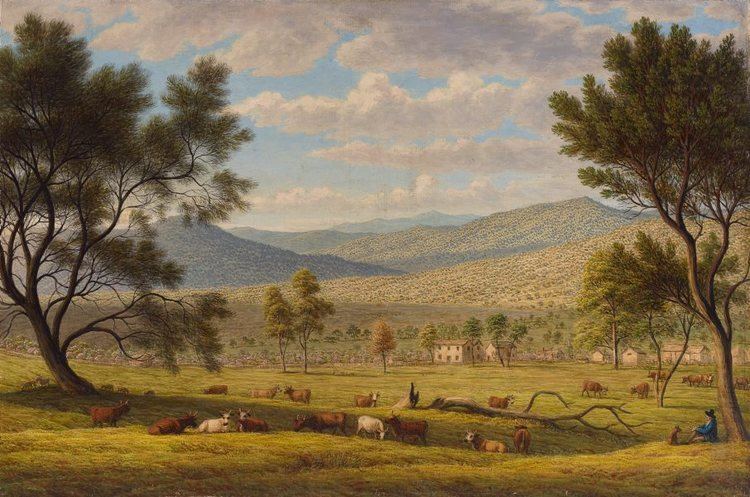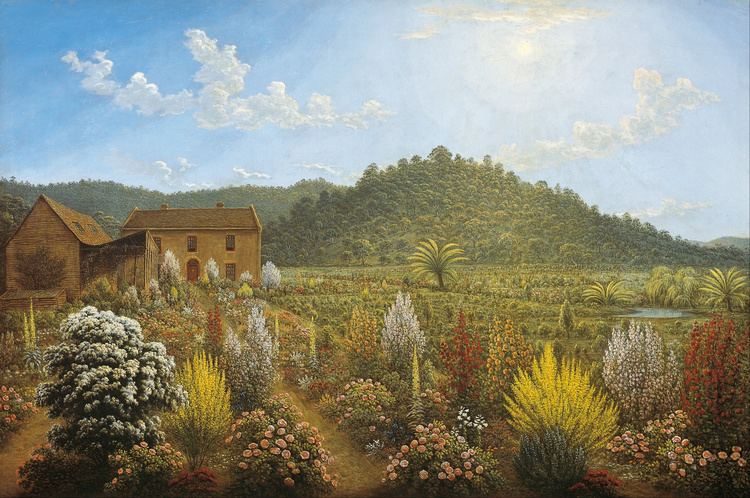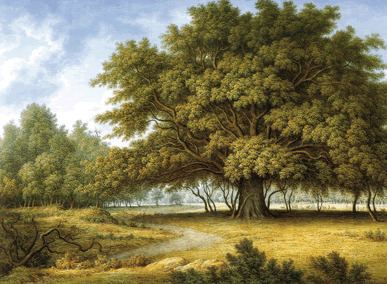Nationality British Role Artist | Spouse(s) Sarah Artwork Mills Plains Name John Glover | |
 | ||
Notable work 'Hobart Town, taken from the garden where I lived', 1832'Mount Wellington and Hobart Town from Kangaroo Point' 1831–33'Natives on the Ouse River, Van Diemen's Land', 1838'Natives at a corrobory, under the wild woods of the Country [River Jordan below Brighton, Tasmania]', ca. 1835'A view of the artist's house and garden, in Mill's Plains, Van Diemen's Land', 1835 Awards Louis XVIII gold medal (for 'Bay of Naples') Died December 9, 1849, Launceston, Australia | ||
Ngv extra john glover the artist
John Glover (18 February 1767 – 9 December 1849) was an English-born Australian artist during the early colonial period of Australian art. In Australia he has been dubbed "the father of Australian landscape painting".
Contents
- Ngv extra john glover the artist
- 07 62257 john glover patterdale landscape with cattle c 1833
- Life in Britain
- Arrival in Australia
- Art in Australia
- Australian legacy
- References

07 62257 john glover patterdale landscape with cattle c 1833
Life in Britain

Glover was born at Houghton-on-Hill in Leicestershire, England. His parents were farmer William Glover and Ann (née Bright). He showed a talent for drawing at an early age, and in 1794 was practicing as an artist and drawing-master at Lichfield. The Countess of Harrington helped establish his practice as an art instructor, and may have taken lessons from him herself. Removed to London in 1805, became a member of the Old Water Colour Society, and was elected its president in 1807. In the ensuing years he exhibited a large number of pictures at the exhibitions of this society, and also at the Royal Academy and the Society of British Artists. He had one-man shows in London in 1823 and 1824. He was a very successful artist and, although never elected a member of the Academy, his reputation stood very high with the public.

Glover achieved fame as a painter of "Italianate" romantic landscapes of Britain (including The falls of Foyers on Loch Ness, the Lake District and London) and Southern Europe. He became known in both England and France as the English Claude. This phrase was making comparison with Glover and the French seventeenth century artist Claude Lorrain, whose works collected by eighteenth century English "grand tourists", strongly influenced the evolution of the English style, in both painting and the layout of landscape gardens.

On 21 October 1825 Glover was one of three passengers on PS Comet II who alighted at Rothesay, thus escaping the disaster which occurred to the paddle-steamer a few hours later when it was hit by SS Ayr and sank in the River Clyde with the loss of 62 lives.
Arrival in Australia
Glover decided to move to Australia, arriving in Van Diemen's Land (now Tasmania) on his 64th birthday in 1831. He brought with him a strong reputation as a landscape painter. From April 1831 until early 1832 he lived in Hobart on a property named "Stanwell Hall", which can be seen in his work Hobart Town, taken from the garden where I lived. In 1832 he acquired one of the largest grants of land in Van Diemen's Land at the time at Mills Plains, Deddington. He named his new property Patterdale after Blowick Farm, a property near Patterdale, at the foot of Ullswater in the Lake District. Glover's grant placed him within close proximity to Kingston, the home of John Batman (later to co-found Melbourne) and his relationship to his neighbour appears to have been fraught. Glover helped build the Chapel at Deddington and is buried within these grounds.
Art in Australia
Glover is best known now for his paintings of the Tasmanian landscape. He gave a fresh treatment to the effects of the Australian sunlight on the native bushland by depicting it bright and clear, a definite departure from the darker "English country garden" paradigm. Note this example Patterdale Farm (circa 1840).
His treatment of the local flora was also new because it was a more accurate depiction of the Australian trees and scrubland. Glover noted the "remarkable peculiarity of the trees" in Australia and observed that "however numerous, they rarely prevent your tracing through them the whole distant country".
Natives on the Ouse River, Van Diemen’s Land (1838) is "informed by European notions of an Antipodean Arcadia, with Indigenous people living in a landscape unsullied by European contact." However, it stands in marked contrast to the actual situation of the traditional owners of Ouse River country - the Braylwunyer people of the Big River nation - which was one of dispossession and violence at the hands of the colonists. John Glover's last major work was painted on his 79th birthday.
Australian legacy
The John Glover Society was established on 22 August 2001 to honour and promote Glover's memory and his contribution to Australian art. The society commissioned a life-size statue of Glover, unveiled in February 2003 in Evandale, Tasmania. It also runs the annual Glover Prize, which is held in Evandale.
John Glover's work features in many prominent art galleries throughout Australia (and the world). His work has been the subject of numerous exhibitions and a symposium in Australia.
From 2004, The John Glover Society has awarded the Glover Prize for depictions of Tasmanian landscapes. It is the richest art prize in Australia for landscape painting.
